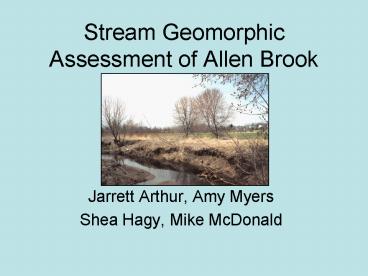Stream Geomorphic Assessment of Allen Brook - PowerPoint PPT Presentation
1 / 21
Title:
Stream Geomorphic Assessment of Allen Brook
Description:
Stream Geomorphic Assessment of Allen Brook. Jarrett Arthur, Amy Myers. Shea Hagy, Mike McDonald ... Lack of adequate riparian buffer zone ... – PowerPoint PPT presentation
Number of Views:61
Avg rating:3.0/5.0
Title: Stream Geomorphic Assessment of Allen Brook
1
Stream Geomorphic Assessment of Allen Brook
- Jarrett Arthur, Amy Myers
- Shea Hagy, Mike McDonald
2
Allen Brook
- Watershed drains
- 12 sq. miles
- Flows into Winooski
- after meeting
- Muddy Brook
3
Characteristics of Impairment
- Presence of pathogens
- High concentration of suspended solids
- Bank failure, erosion
- Lack of adequate riparian buffer zone
- Channelization leading to decrease in natural
stream hydrological features such as pools and
riffles
4
Methods
Phase One Steps
Phase Two Steps
Rapid Geomorphic Rapid Habitat
Assessment Assessment
2.1 Elevation 5.2 Bridges-Culverts
2.2 Valley Length 5.3 Bank Armoring
2.3 Valley Slope 5.4 Channel Modification
2.4 Channel Slope 5.5 Dredging History
2.5 Sinuosity 6.1 Berms and Roads
2.6 Watershed Size 6.2 River Corridor Development
2.7 Channel Width 6.3 Depositional Features
2.8 Valley Width 6.4 Meander Migration
2.9 Confinement 6.5 Meander Width Ratio
2.10 Stream Type 6.6 Wavelength Ratio
3.1 Alluvial Fan 7.1 Dominant Bed Form and Material
3.2 Grade Controls 7.2 Bank Erosion/Bank Height
3.3 Geologic Materials 7.3 Ice and Debris Jam Potential
3.4 Valley Side Slopes 8.1 Impact Rating
3.5 Soil Properties 8.2 Priority Rating
4.1 Watershed Land Cover 9.1 Channel adjustment Process
4.2 Corridor Land Cover 9.2 Reach Condition
4.3 Riparian Buffers 9.3 Reach Sensitivity
4.4 Ground Water Inputs 10 Like Reach Evaluation
5.1 Flow Regulation
6.1 Epifaunal Substrate/ Available Cover 7.1 Channel Degradation (Incision)
6.2 Embeddedness 7.2 Channel Aggradation
6.3 Velocity/Depth Patterns 7.3 Channel Widening
6.4 Sediment Deposition 7.4 Change in Planform
6.5 Channel Flow Status
6.6 Channel Alteration
6.7 Frequency of Riffles/Steps
6.8 Bank Stability
6.9 Bank Vegetative Protection
6.10 Riparian Vegetative Zone Buffer
5
Reach Designation
6
M3T3.11
- Culvert
- Dense Sprawly Surroundings
- Buffer Reclaimed
- Field Grass
- Golden Rod
- Deep Plunge Pool
- Braided Channel
7
M3T3.10
- Buffers Widen
- Braiding Ends
- Cobbles and Boulders
- Bank Failure provides Coarse Woody Debris
- Channel migration
- Undercutting
- Point bars
- Channel Widening
8
M3T3.9
- Transition Zone
- Degrad. and Aggrad. Present Throughout
- Banks Flat and Broad
- Wetland Area on Lower Portion of Right Bank
- Left Bank Supports Larger Trees
- Beds Still Dominated by Cobbles but Embeddedness
is Occuring
9
M3T3.8
- First Impaired Reach
- Area Surrounding the right bank is wetland
- There is a large pond within 20 feet of the
stream bank - Less Trees throughout reach
- Right Buffer Gets Thinner Downstream
- Old Farm Field Creeping in on Left Bank
- Embeddedness Occurs Throughout
- Erosion occurrs on the outside of meanders.
10
M3T3.7
- Dramatic Deterioration From Previous Reach
- Buffers become nonexistent
- land appears to have been cleared for farm
pasture or crop - field grass is dominant species
- The right bank is very wet and even has
intermittent hydric soils. - Willow Grows Thinly in the Stream Channel
- Streambed is Sand
- Evidence of Head Cutting Exists
- Incision is Dominant Force
- Right Bank has Some Hydric Soils
11
M3T3.6
- Final Assessed Reach
- Begins and Ends at a Road Crossing with a Culvert
- Surrounding Landscape is Flat
- Reach is Deeply Incised
- Broad Meander Migration Occurring
- Streambed is Mostly Sand only Broken by Litter
- Prevailing Land use is Suburban Residential
Development - Prior to development, farmland predominated
- The resulting ground cover is uniform field
grasses.
12
(No Transcript)
13
(No Transcript)
14
Results
Figure 1. Rapid Habitat Assessment of impaired
reaches compared to the attainment reaches
Allen Brook, 2004.
15
Figure 2. Rapid Geomorphic Assessment of
impaired reaches as compared to attainment
reaches Allen Brook, 2004.
16
Figure 3. Rapid Habitat Assessment compared to
the watershed condition on all six reaches
Allen Brook, 2004.
17
Figure 4. Rapid Geomorphic Assessment compared
to the watershed condition on all six reaches
Allen Brook, 2004.
18
Figure 5. Rapid Habitat Assessment scores
compared to the Rapid Geomorphic Assessment
scores for all six reaches Allen Brook, 2004.
R2.9529
19
Conclusions
- Our impaired reaches are significantly more
degraded than our attainment reaches both in
terms of geomorphic processes and habitat
suitability - The degree of impairment in all of our reaches
increases in severity the further downstream the
reach is located. - Current land development surrounding Allen Brook
combined with the historic use of land for
agricultural purposes has caused the health of
the brook to decrease and the abundance of native
aquatic life to suffer. - Assessment of stream condition using the ANR
stream geomorphic protocols correlated to
assessment using biocriteria.
20
Recommendations
- The implementation of soft engineering to
stabilize failing banks may be able to reduce
further degradation and erosion. - The restoration of a riparian buffer of adequate
width will help reduce runoff volume, velocity,
increase nutrient retention, provide shading, and
habitat. - Best Management Practices (BMPs) will help reduce
the detrimental effects of surrounding
agricultural and residential land.
21
Acknowledgements
- Special thanks to Bill Gill in the library for
all the help, especially at ridiculous hours of
the night, and to Breck Bowden for advice and
guidance throughout the whole process.































